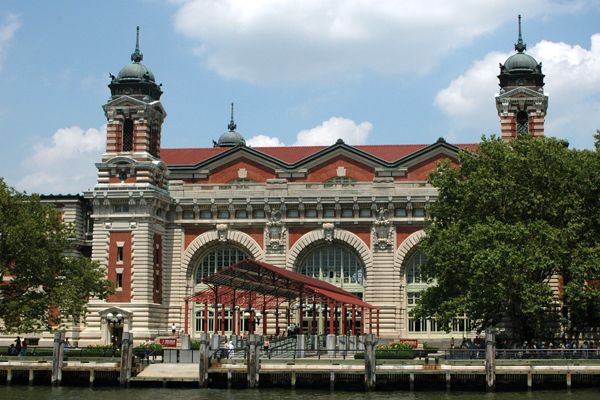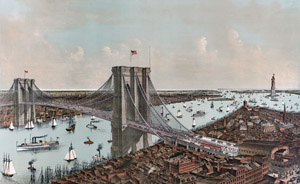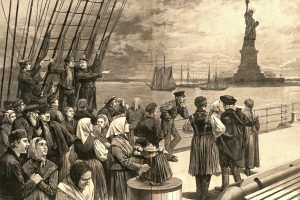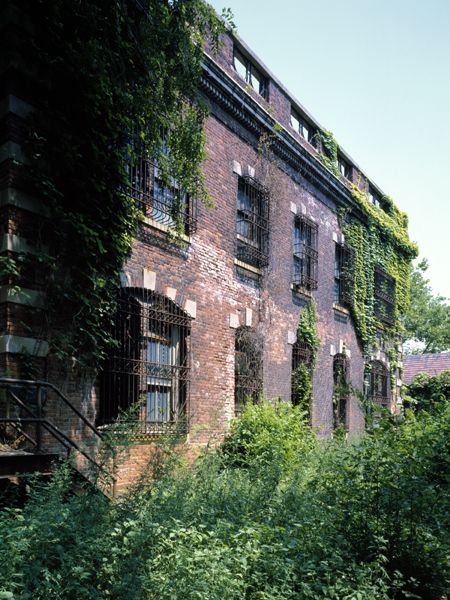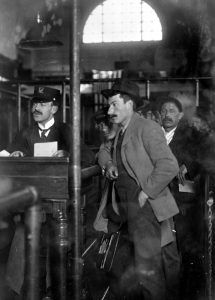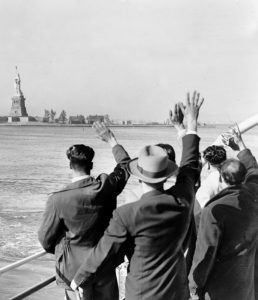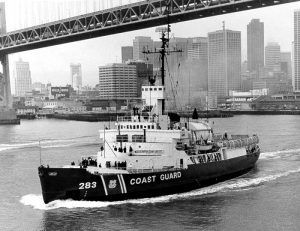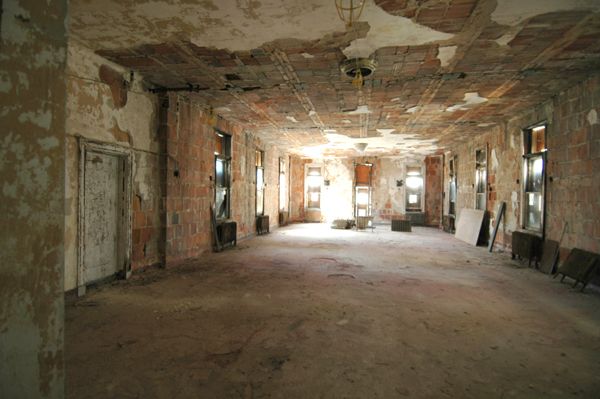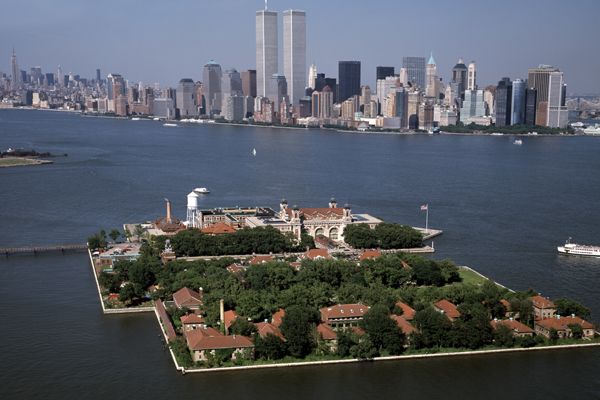From 1892 to 1924, Ellis Island was America’s largest and most active immigration station, where over 12 million immigrants were processed. On average, the inspection process took approximately 3-7 hours. For most immigrants, Ellis Island truly was an “Island of Hope” – the first stop on their way to new opportunities and experiences in America. For the rest, it became the “Island of Tears” – a place where families were separated and individuals were denied entry into the United States.
Henry Hudson arrived in what is now New York Bay in 1609. In 1624, the Dutch established a fur trading station on Governor’s Island and, in 1625, founded New Amsterdam in Lower Manhattan. In 1664, the English took possession of New Netherland from the Dutch, renaming it New York. Between 1674 and 1679, Ellis Island, at that time called one of the three “Oyster Islands” in New York Harbor, was granted to Captain William Dyre (the collector of customs and future mayor of New York) by the Colonial Governor of New York, Sir Edmund Andros. During Dyre’s ownership, this Oyster Island was renamed Dyre’s Island.
For the next 100 years, the island went through a succession of owners and names. In 1774, Samuel Ellis, a New York merchant, purchased the island. “That pleasantly situated island,” as Ellis called it in an ad for its sale in 1785, was a favorite spot for those who wanted to dig for oysters or enjoy the view of New York’s bustling harbor while visiting the tavern he built there. Ellis failed to sell his island, which his descendants inherited after he passed away in 1794. In 1808, New York State bought the property with several claimants and then conveyed ownership to the United States government.
In the early 1800s, the young American government realized that Ellis Island, with its clear view of the entrance to New York Harbor, had strategic value as a defense post. Since the British had easily invaded New York with little resistance during the American Revolution, protecting New York became a top priority for the new government. Preceding the War of 1812, the United States War Department constructed Fort Gibson on Ellis Island. Fort Gibson consisted of barracks for a small garrison, a powder magazine, and a battery of guns along the island’s eastern edge.
Other newly erected or refurbished forts along New York harbor included Fort Hamilton in Bay Ridge, Brooklyn; Fort Wadsworth on Staten Island; Fort Wood on Liberty Island; Fort Clinton in Manhattan (now known as Castle Clinton), and Fort Columbus and Fort Williams on Governor’s Island. Like its counterparts around New York Bay, Fort Gibson never saw action. The British blockaded the harbor during the war but never directly attacked the city.
In 1891, the federal government assumed responsibility from the states for regulating immigration through the Immigration Act of 1891, which established the Office of Immigration (later the Bureau of Immigration) to administer immigration affairs. The government also appropriated money to build a new immigrant inspection station on Ellis Island. The Immigration Act assigned the Marine Hospital Service (later the Public Health Service) the responsibility of examining the health of immigrants entering the United States.
Before the construction of Ellis Island’s first immigration depot began, the island was doubled in size with a landfill. A ferry slip was dredged, and a dock was installed next to the leading building site. Several older buildings from the island’s time as a military post were adapted for re-use. Ellis Island’s first immigration building, constructed of Georgia pine, opened on January 1, 1892.
Due to the economic depression, immigration was light, and Ellis Island inspectors had no difficulty processing the fewer than 20,000 immigrants who arrived annually. On June 15, 1897, a fire destroyed the complex of wooden buildings. Although 140 immigrants and numerous employees were on the island, no one was killed.
The government immediately announced that Ellis Island would be rebuilt with fireproof buildings. The first building was the new Main Immigration Building, which opened on December 17, 1900. Following its completion, the Kitchen, Laundry, and Powerhouse buildings were erected in 1901, and a landfill enlarged the island to make room for a hospital complex. In March 1902, the Main Hospital Building opened. The hospital had space and equipment to care for 125 patients. However, it was still not enough–the hospital was overwhelmed with patients diagnosed with trachoma, favus, and other contagious illnesses that warranted exclusion. Over the next seven years, additional buildings were added to the hospital complex, including the Hospital Addition/Administration Building, the New Hospital Extension, and the Psychopathic Ward. The island was also enlarged using a landfill, which allowed for the construction of a Contagious Disease Hospital, Isolation Ward, and additional support buildings.
On a typical day at the Ellis Island Immigration Station, immigrants met with inspectors, interpreters, nurses, doctors, social workers, and many others. As a sizeable federal facility employing approximately 500 employees, Ellis Island had a well-organized workforce.
The complex work of processing thousands of immigrants a year required a full complement of staff. Some names are known; others remain anonymous, but all of them contributed to the primary function of the Immigration Station on Ellis Island — to ensure that newcomers to the United States were legally and medically fit to enter the country.
The Emergency Quota Act, passed in 1921, ended the U.S.’s open-door immigration policy. The law significantly reduced the number of admissions by setting quotas according to nationality. The number of nationalities that could be admitted to the United States was limited to 3% of that nationality’s representation in the U.S. census of 1910. The law created havoc for those on Ellis Island, and thousands of immigrants were stranded on the island awaiting deportation. The island sometimes became so overcrowded that officials had to admit excess-quota immigrants.
The First Quota Act was replaced with the more restrictive Immigration Act of 1924. This act further limited admissions of each nationality to the United States to 2% of that nationality’s representation in the 1890 census. The act sought to limit admissions to the United States and curtail immigration of southern and eastern Europeans, who by the 1900s comprised over 50% of the immigrant flow. Additionally, the Immigration Act of 1924 allowed prospective immigrants to undergo inspection before leaving their homeland, making the trip to Ellis Island unnecessary.
Anti-immigration legislation passed in the 1920s, and the Great Depression kept immigration at an all-time low. For the first time in Ellis Island’s history, deportation far outnumbered admissions. Given this situation, the Ellis Island Advisory Committee (a committee appointed by the Department of Labor under Franklin D. Roosevelt’s New Deal program) advised that new buildings be erected for detained immigrants to separate them from deportees, who were often criminals. This final construction surge included the New Immigration Building, New Ferry House, and the new Recreation Building and Recreation Shelters.
From 1939 to 1946, the United States Coast Guard occupied Ellis Island and established a training station that served 60,000 enlisted men and 3,000 officers. They utilized many buildings on the island. For example, the Baggage and Dormitory Building was a drill room, armory, boatsman storeroom, carpenter’s shop, and machine shop. The Kitchen and Laundry Building was utilized as a kitchen and bake shop. Lastly, the New Immigration Building provided dormitories for the men. After their time at Ellis, the enlisted men and officers were primarily responsible for manning transports, destroyer escorts, cutters, and submarine chasers during World War II. Although the training station was decommissioned in 1946, the Coast Guard returned to the Island in 1951 and established a Port Security Unit. They utilized numerous buildings, including the recreation buildings and hospital complex, as offices until the abandonment of Ellis Island in 1954.
Although the Coast Guard utilized many of the buildings on Ellis Island during World War II, the Main Immigration Building and hospital complex were not under their jurisdiction. During World War II, German merchant mariners whose ships had been seized at American ports were quartered in the Baggage Room until they were transferred to inland detention camps. Additionally, arrested “enemy aliens” and their families were detained in the Main Immigration Building. The Alien Registration Act of 1940 required all “resident aliens” to be registered and fingerprinted. A 1941 Presidential proclamation identified all citizens of Japan, Germany, and Italy residing in the United States as “alien enemies.” Those aliens who were suspected of being potentially dangerous could be detained. The Registry Room was used as family day quarters for enemy aliens who, by 1942, numbered about 1,000. Desperately needed living space for detainees was created in 1943 when all Ellis Island’s administrative workers moved to a Manhattan office. Although the Registry Room was not used as a medical ward, as it had been during World War I, wounded U.S. veterans of World War II were treated in the hospital complex.
After the war, Ellis Island’s functions returned to normal – immigrant officials processed detained immigrants and deported those who could not legally live in the United States. Immigrant numbers, however, were dwindling, and by 1949, there was talk of closing the island.
The Korean and Cold Wars of the 1950s extended the life of Ellis Island. After the passage of the Intern Security Act of 1950 (an act that prohibited entry to any person affiliated with a totalitarian organization or Communism), the detainee population of the island increased from 400 people to 1,200 people. In 1951, strict enforcement of the Intern Security Act and growing anti-Communist pressures led to a mass roundup of aliens illegally residing in the New York area. These aliens were held on Ellis Island without bail and were joined by seamen who deserted their ships and stowaways. By 1953, however, congestion on the island subsided.
In November 1954, the Immigration and Naturalization Service closed its offices on Ellis Island and moved to a new location in Manhattan. The need for Ellis Island had slowly diminished since 1924 when Congress instituted quota laws that drastically reduced the number of immigrants entering the United States each year. Processing of immigrant visas at American consular offices overseas further reduced the need for Ellis Island. By March of 1955, Ellis Island was declared surplus Federal property. The silent, empty immigration depot rapidly deteriorated into a ghostly complex of dilapidated buildings.
In 1965, President Lyndon B. Johnson signed a proclamation that recognized the historical significance of Ellis Island by incorporating it into the Statue of Liberty National Monument, National Park Service. Liberty’s 1986 centennial sparked an ambitious project to repair and refurbish the Statue and the Main Immigration Building on Ellis Island. The National Park Service and the Statue of Liberty – Ellis Island Foundation, with the generous help of the American people, spearheaded a restoration effort of unprecedented scale. The work was accomplished by a team of architects and artisans who spent years researching, planning, and finally restoring Ellis Island’s main building to its appearance from 1918 to 1924.
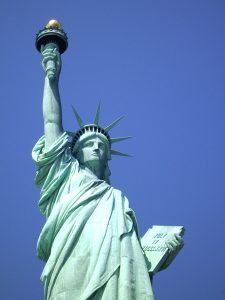
The Statue of Liberty, photo by 9-year-old Ella Nobo,
Legends of America’s granddaughter in training.
More Information:
Ellis Island Museum of Immigration
Statue of Liberty National Monument
New York, NY 10004
212-363-3200
Compiled & edited by Kathy Alexander/Legends of America, updated January 2024.
Also See:
Immigration – The First Gateway
Immigration – Challenges For New Americans
Liberty Island & the Statue of Liberty
Source: National Park Service

